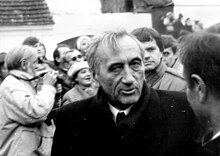Thick line
The thick line policy (Polish: gruba kreska, thick stroke, or gruba linia, thick line) was the term used by prime minister of Poland, Tadeusz Mazowiecki, in the exposé[pl] delivered in the Sejm, on September 12th 1989.[1]
He said, "We split away the history of our recent past with a thick line. We will be responsible only for what we have done to help extract Poland from her current predicament, from now on". (Przeszłość odkreślamy grubą linią. Odpowiadać będziemy jedynie za to, co uczyniliśmy, by wydobyć Polskę z obecnego stanu załamania.)[2]

In more recent years, his intentions were considered by many people, and his gruba kreska is often understood as a policy of nonpunishment for crimes committed by the communist regime of pre-1989 Poland.[3][4][5]
See also
[edit]Notes and references
[edit]- ^ Gerald J. Beyer, "What Ever Became of Solidarity?" America magazine, January 16, 2006. Retrieved October 20, 2011.
- ^ Dominika Blachnicka - Ciacek, Reading Mazowiecki's expose twenty years later
- ^ Tadeusz Mazowiecki, Solidarity Takes Power
- ^ D. Szporer, Solidarity: The Great Workers Strike of 1980 on Google books
- ^ Daniela Ivanova, Tadeusz Mazowiecki
